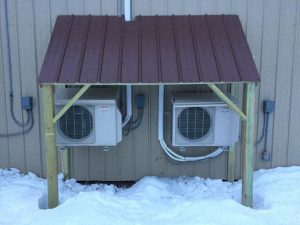Heat pump technology continues to improve, but heat pumps are still not effective when temperatures are below freezing. There is a simple answer to the question, but it is essential to know how heat pumps work first.
How Heat Pumps Work
As the name implies, heat pumps carry or pump heat from one location to another. In the summer, they air condition your home by collecting heat inside and carrying it outside. In winter they heat it by reversing the process.
A heat pump is made up of an outside unit known as the condensing unit. It contains a compressor, an outdoor coil, a fan and supporting parts. Inside your home, in the air handler or gas furnace, is the indoor coil for the heat pump. Two refrigerant lines connect the indoor coil to the condensing unit. They are used to circulate refrigerant.
When heating, refrigerant is pumped into the outdoor coil by the compressor. There, it evaporates into a gas and collects heat in the process. Think of water evaporating off of your skin, carrying heat with it and cooling your skin. The refrigerant evaporates into a gas and gets very hot. It’s hard to believe, but there is sufficient heat outside even in winter to collect enough to heat your home, at least when the temperature is not freezing cold.
The hot gas refrigerant is pumped into your home through the first refrigerant line. It enters the indoor coil, passes through a valve and condenses back into a liquid. The heat is forced out of it by this process. The indoor coil gets very hot. The blower fan of the air handler circulates air over the coil to heat it before pushing it into your home via the duct work.

The cooled refrigerant then circulates back outside through the second refrigerant line to collect more heat. This process is continuous until enough heat has been brought inside to raise the temperature to the desired level.
The Problem with Heat Pumps on Very Cold Weather
As the temperature outside drops, the refrigerant is able to capture less and less heat. Once the temperatures fall into the mid-30s to about freezing, today’s heat pumps cannot effectively gather enough heat to do the job. When temperatures are very cold, a different heat source must be used. For this reason, heat pumps were not used in cold climates until recently.
Dual Fuel Heat Pumps are the Solution in Cold Climates
Many heat pump brands now make dual fuel heat pumps. They contain a few extra parts that allow them to alternate heat with a gas furnace. The system is set to automatically switch to the gas furnace when the outdoor temperature drops to a programmed number; it switches back to the heat pump when the outdoor temperature rises. The advantage of such a system is two-fold. First, your home is adequately heated. Secondly, the heat pump is used as much as possible. Since heat pumps are much more efficient than even high-efficiency gas furnaces, this gives you the lowest possible heating bills.
If winter temperatures regularly fall into the mid-30s or below where you live, take a few minutes to learn about the advantages of dual fuel heat pumps. You’ll find quite a few in our heat pump ratings. You can read more about them in many of the general articles on this site too.



